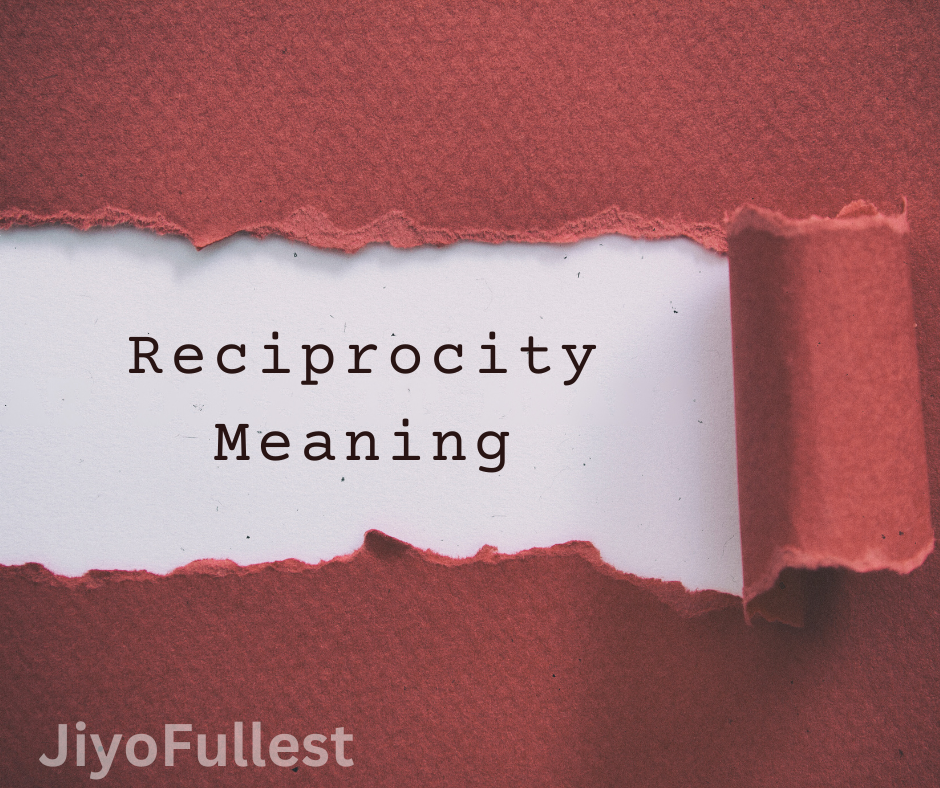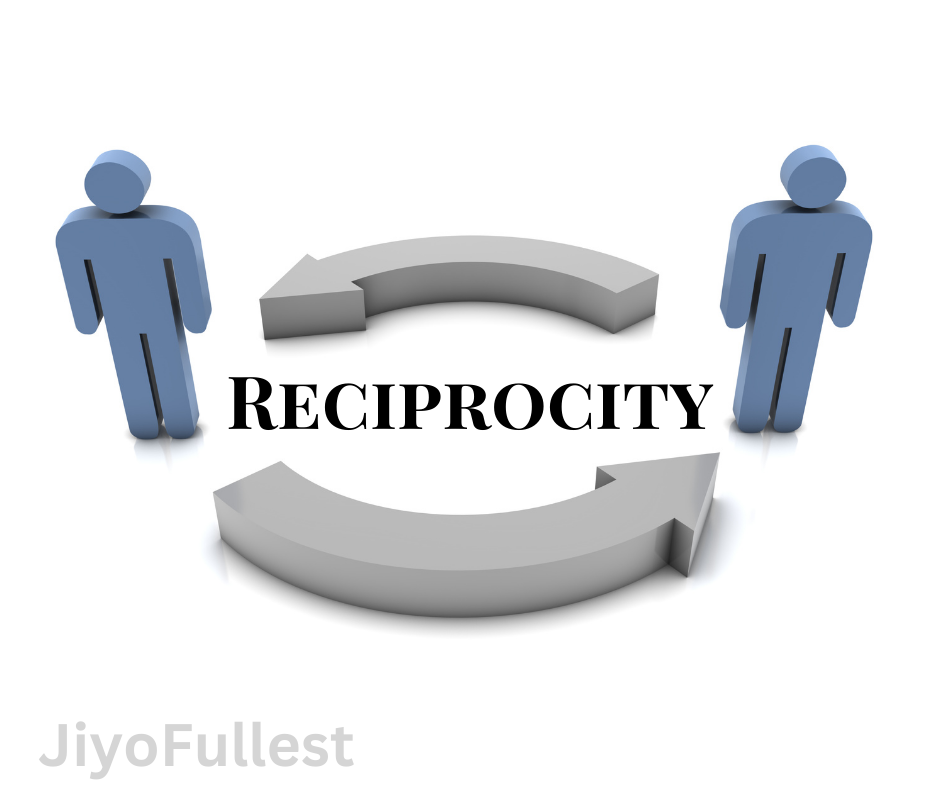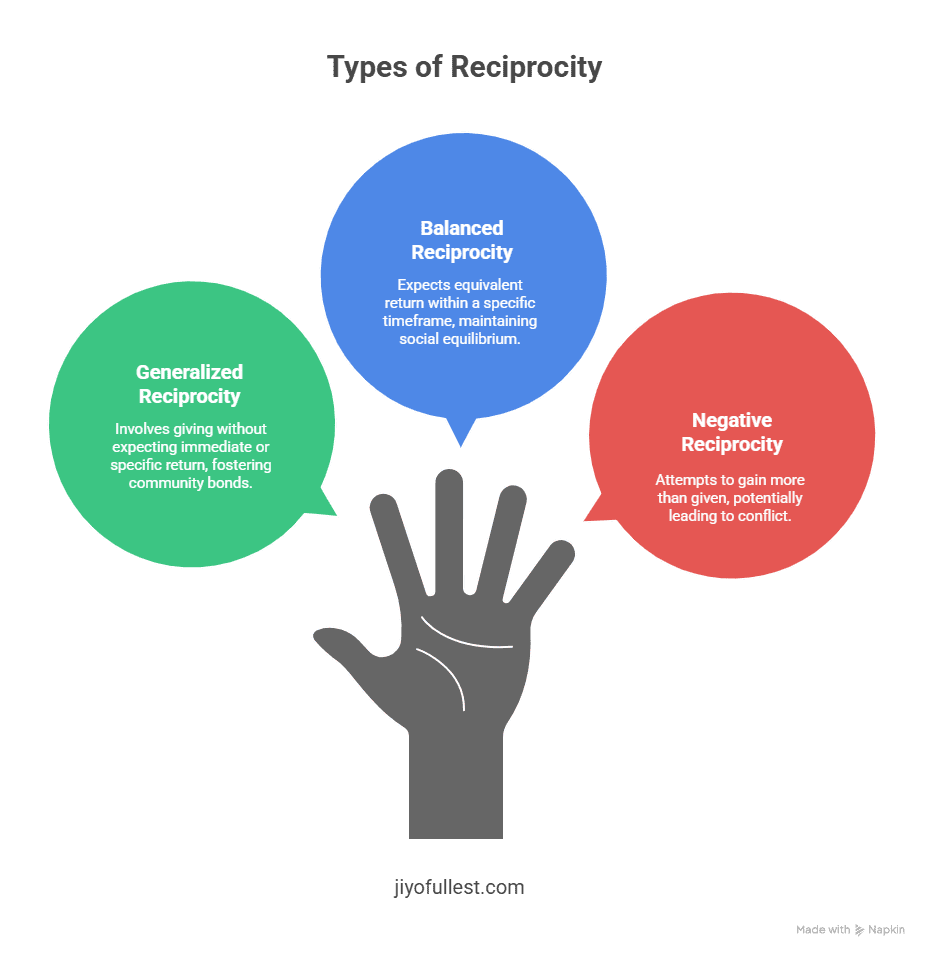Reciprocity, a fundamental concept in social psychology and human interactions, embodies the principle of mutual exchange and mutual benefit. At its core, reciprocity entails the practice of responding to positive actions with positive actions, creating a cycle of give-and-take that fosters trust, cooperation, and social cohesion. In this blog, we will delve into the meaning of reciprocity, explore its significance in psychology and social dynamics, and provide examples to illustrate its application in everyday life.
Table of Contents
ToggleReciprocity Meaning and Definition:
Reciprocity, derived from the Latin word “reciprocus,” refers to the practice of exchanging things with others for mutual benefit. In essence, it involves the mutual exchange of favors, gifts, or acts of kindness between individuals or groups. The concept of reciprocity is deeply rooted in various cultures and societies worldwide, serving as a cornerstone of social relationships and community bonds.
Reciprocity Synonyms:
Synonyms for reciprocity include:
- Mutual exchange
- Give-and-take
- Mutual benefit
- Quid pro quo
- Cooperation
- Interdependence
- Mutual aid
- Tit for tat
- Mutual assistance
- Mutual understanding
These synonyms capture the essence of reciprocity, which involves the exchange of actions, favors, or benefits between individuals or groups for mutual advantage or cooperation.

Law of Reciprocity
The law of reciprocity posits that individuals tend to reciprocate both positive and negative actions they receive from others. This psychological principle underscores the innate human tendency to respond to kindness with kindness and generosity with generosity. As a result, acts of goodwill and benevolence often trigger reciprocal responses, fostering a sense of reciprocity and interconnectedness within social networks.
Reciprocity in Psychology:
In psychology, reciprocity plays a pivotal role in shaping interpersonal relationships, trust, and cooperation among individuals. It operates on both conscious and unconscious levels, influencing behavior and social interactions in subtle yet profound ways. Reciprocity fosters feelings of goodwill and gratitude, strengthening social bonds and promoting prosocial behavior within communities.
Social Reciprocity
Social reciprocity encompasses a wide range of behaviors and interactions characterized by mutual exchange and cooperation. From simple acts of politeness and courtesy to more significant gestures of generosity and support, social reciprocity shapes the dynamics of interpersonal relationships and group cohesion. It contributes to the formation of social norms, expectations, and mutual obligations that govern social interactions.

How to Practice Reciprocity?
Reciprocity manifests in various forms across different contexts and cultures. Examples include:
Gift-Giving: Exchanging gifts during holidays, birthdays, or special occasions reflects the principle of reciprocity, as individuals reciprocate the generosity shown to them by others.
Random Acts of Kindness: Random acts of kindness, such as holding the door for someone or offering assistance to a stranger in need, often elicit reciprocal responses and contribute to a positive cycle of goodwill.
Networking and Collaboration: In professional settings, reciprocity plays a crucial role in networking and collaboration. Individuals who offer support, advice, or opportunities to others are likely to receive reciprocal gestures in return, fostering mutually beneficial relationships.
Social Support: Providing emotional support, empathy, or assistance to friends, family members, or colleagues during challenging times exemplifies reciprocity in interpersonal relationships, as individuals reciprocate care and support when needed.
In conclusion, reciprocity serves as a cornerstone of social interactions, fostering mutual trust, cooperation, and goodwill among individuals and communities. By understanding the principles of reciprocity and incorporating them into our daily interactions, we can cultivate stronger relationships, build social capital, and contribute to the well-being of society as a whole.

Reciprocity Examples:
Real-life example of negative reciprocity
- when a business exploits customers by overcharging for scarce goods during emergencies, demonstrating exploitative behavior and the darker side of reciprocal interactions.
- when two businesses engage in competitive undercutting, where one company lowers its prices to attract customers away from a competitor, and the competitor responds by further lowering its prices.
This kind of behavior can lead to a price war, where both parties suffer reduced profits. Negative reciprocity here reflects a retaliatory exchange aimed at gaining an advantage over the other, often at the expense of both parties involved. This scenario demonstrates the concept of negative reciprocity, where actions are taken to harm or disadvantage the other, contrary to the mutual benefit seen in positive reciprocity.
In sociology:
In sociology, reciprocity is exemplified by mutual aid societies where members contribute to a common fund to support each other in times of need, illustrating societal reciprocity and collective cooperation.
In humans:
Reciprocity in humans is the practice of exchanging things with others for mutual benefit, highlighting the importance of give and take in human relationships and societal bonds.
In human nature:
Reciprocity in human nature is the innate tendency to engage in a give-and-take manner, fostering relationships and community connections, and is a core element of human social behavior.
In life:
Example of reciprocity in life involves acts of kindness and exchange, like when one person gifts another, and the receiver later returns the favor, illustrating the reciprocal relationship principle in everyday interactions.
In children:
Examples of reciprocity in children include sharing toys, taking turns in games, or helping each other with tasks, reflecting the early development of reciprocal behavior and social exchange in youth.
Generalized reciprocity:
The best example of generalized reciprocity is a parent’s care for their child, where the giver (parent) expects nothing immediate in return, epitomizing unconditional giving and altruistic reciprocity.
What is a real-life example of reciprocity norm?
A real-life example of the reciprocity norm is when neighbors share resources during a crisis, expecting that others will reciprocate in times of need, demonstrating community support and social reciprocity.
What is reciprocity in human behavior?
Reciprocity in human behavior refers to the mutual exchange of favors or services, where individuals respond to others’ actions with similar actions, a fundamental aspect of human social interaction and reciprocal dynamics.

Types of Reciprocity
In social psychology and anthropology, there are three main types of reciprocity:
1️⃣ Generalized Reciprocity
Definition: Giving without expecting anything immediate in return.
Example: Parents caring for their children or helping a friend move without asking for anything.
Key Point: It’s often seen in close relationships, where trust and mutual support are valued over keeping score.
2️⃣ Balanced Reciprocity
Definition: Giving with the expectation of a roughly equal return within a specific timeframe.
Example: Gift-giving between friends or colleagues, or splitting dinner costs.
Key Point: This type is common in social and professional settings, maintaining fairness and equality.
3️⃣ Negative Reciprocity
Definition: Taking more than you give — seeking to maximize one’s own gain at another’s expense.
Example: Haggling in markets, aggressive negotiations, or exploitative practices.
Key Point: It’s more transactional and self-serving, often found in competitive or distant interactions.

What is Reciprocity in Relationships?
Reciprocity in relationships refers to the mutual exchange of actions, emotions, support, and benefits between individuals within a relationship. It involves a give-and-take dynamic where both parties contribute to the relationship in a balanced and equitable manner. Reciprocity in relationships refers to the mutual exchange of actions, emotions, support, and benefits between individuals within a relationship. It embodies the principle of give-and-take, where both parties contribute to the relationship in a balanced and equitable manner. Reciprocity fosters a sense of mutual understanding, trust, and cooperation, strengthening the bonds between individuals and promoting a healthy dynamic within the relationship.
In the context of interpersonal relationships, reciprocity can manifest in various forms:
Communication: Reciprocity in communication entails active listening, respect for each other’s perspectives, and open dialogue. It involves sharing thoughts, feelings, and concerns openly and honestly, while also being receptive to the other person’s viewpoints and experiences.
Shared Responsibilities: Reciprocity involves sharing responsibilities and tasks within the relationship, whether it’s household chores, financial obligations, or decision-making. Both partners contribute their fair share to the relationship, recognizing and appreciating each other’s efforts.
Acts of Kindness: Reciprocity encompasses acts of kindness, thoughtfulness, and appreciation. It involves expressing gratitude, showing appreciation for each other’s efforts, and engaging in thoughtful gestures that demonstrate care and affection.
Trust and Loyalty: Reciprocity builds trust and loyalty within the relationship. It involves honoring commitments, respecting boundaries, and being dependable and reliable partners to one another.
Mutual Growth and Support: Reciprocity encourages mutual growth and support within the relationship. It involves encouraging each other’s personal and professional development, celebrating achievements, and offering encouragement and motivation during times of uncertainty or self-doubt.
Emotional Support: Reciprocity involves offering emotional support, empathy, and understanding to one another during times of need. It entails being there for each other, listening attentively, and providing comfort and reassurance when faced with challenges or difficulties.
Overall, reciprocity is a fundamental aspect of healthy and fulfilling relationships. It creates a sense of balance, fairness, and mutual respect, where both partners feel valued, understood, and supported in their journey together. By practicing reciprocity, individuals can nurture strong and meaningful connections that stand the test of time.
FAQs on Reciprocity
How does reciprocity contribute to healthy relationships?
Reciprocity fosters trust, cooperation, and mutual understanding within relationships. It encourages open communication, shared responsibilities, and acts of kindness, leading to a stronger and more fulfilling connection between individuals.
What are some examples of reciprocity in relationships?
Examples of reciprocity in relationships include providing emotional support during challenging times, sharing responsibilities and tasks, communicating openly and honestly, showing appreciation through acts of kindness, and building trust and loyalty through mutual understanding.
Is reciprocity necessary for a successful relationship?
Reciprocity is an essential element of successful relationships as it promotes fairness, respect, and mutual benefit. It helps create a positive and harmonious dynamic where both partners feel valued, understood, and supported.
How can I practice reciprocity in my relationships?
You can practice reciprocity in your relationships by actively listening to your partner, expressing gratitude and appreciation, sharing responsibilities and decision-making, offering emotional support, respecting boundaries, and being dependable and reliable.
What are the benefits of practicing reciprocity in relationships?
Practicing reciprocity in relationships leads to increased trust, stronger emotional bonds, improved communication, enhanced cooperation, mutual growth and support, and a greater sense of satisfaction and fulfillment in the relationship.
What should I do if I feel that reciprocity is lacking in my relationship?
If you feel that reciprocity is lacking in your relationship, it’s important to communicate openly with your partner about your concerns. Discuss your expectations, listen to each other’s perspectives, and work together to find ways to enhance reciprocity and balance in the relationship.
What is an example of the practice of reciprocity?
An example of the practice of reciprocity is when a friend lends you money during hardship, and you repay them later, showcasing reciprocal altruism and the ethics of reciprocity in personal relationships.

